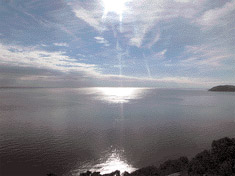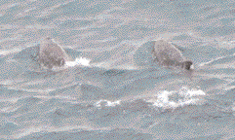| Dalkey Tidy Towns |
  |
| Dalkey Tidy Towns |
  |
|
Wildlife
Newsletter for the Township of Dalkey November. 2010 - Michael Ryan |
| HAPPY
MONDAY A gloomy cool Monday morning. There was a milky light appearing in the east but nothing resembling sunshine. As we came down the hill past the aircraft beacon we heard somebody roaring from the woods ahead. The remains of an all night drinking party, we’d frequently meet youths hanging over, in every sense of the world, after a long night’s session and generally they’d mind their own business. Sometimes people would come up to the hill top to see the sun appearing above the sea but this didn’t sound like some one having a spiritual moment bonding with the wonders of nature so we thought we’d better avoid them. We went a longer way through the woods and then walked up the back of Killiney hill to the obelisk and back. As we came round the bend on the path, known locally as the Green Road, above the Vico Road we saw one of our friends staring intently down at the sea. There’s a little group of regular early morning dog walkers who know each other and often, when meeting, biscuits are exchanged between dogs. I don’t |
 View
from Killiney Hill View
from Killiney HillPhoto: Michael Ryan |
| mean the dogs give each other biscuits but the owners give biscuits to the other walker’s dog. Her dog came over to me for her breakfast bikkie and it was only when my dog started getting impatient for her bikkie I noticed our friend hadn’t noticed her because she was staring intently down at the sea. What was she looking at? Dolphins, she announced! At first my natural cynicism came to the fore. There are often Porpoise to be seen swimming along near to the coast. They’re much smaller then dolphins and you only ever see a small dorsal fin and a bit of their back as they rise out of the water. They don’t leap out of the sea, playfully nudge swimmers or do anything acrobatic although it’s always exciting to see them. They are sometimes mistaken for dolphin’s and initially I thought maybe that’s what our friend had seen but I was very wrong. These weren’t porpoise. Not much more then a hundred yards off the Vico Road were at least three dolphins. |
| Leaping up clear of the water and diving back in, tail fins high in the air, this was a spectacular sight. We watched them for 10 or 15 minutes and leaving them was difficult because they showed no sign of swimming away and were staying in the same general area. But an hour later I drove down to the Vico, parked and had a look. They were still there, just off the bathing place near the cove at Sorrento Terrace. From the Vico Road they were in that close to the shore I was looking down on them. I could hear early morning swimmers whooping with excitement as they watched them. Two dolphins leaped out of the water facing each other like synchronized swimmers and sometimes three dolphins would swim side by side almost touching as they surged through the waves. I took loads of photos, which were virtually all rubbish, most showing the broken surface where the dolphin had just dived back in. Afterwards I thought I should have forgotten about the photos and just watched them, the photos would never capture their grace or my excitement. I also thought afterwards if it wasn’t for the shouting from the woods earlier I’d have gone a shorter route and passed our friend before she’d seen the dolphins so I probably wouldn’t have seen them. Every few minutes a Dart would go by |
 Dolphins
in Killiney Bay Dolphins
in Killiney BayPhoto: Michael Ryan |
| and
I was wondering did any of the passengers see them, clearly visible below
them if they were looking in the right direction. That would lift anybody’s
Monday morning, it certainly did mine. Next Sunday we were on top of Killiney
Hill near the obelisk and scanning the bay. I, of course, didn’t see
anything and had wandered off but my sharp-eyed companion called me back and
directed my gaze to what she’d seen beside a sailing boat near Dalkey
Island. A few metres off its stern dark shapes were breaking the surface and
our binoculars clearly made out the dolphins although you could easily see
them with the naked eye as they launched out of the water. Don’t know
if they were following the boat or the boat was following them. We watched
them again for ages, they came nearer the shore swam just past the beach at
White Rock and headed south. Three Bottlenose Dolphins had been reported many times between Greystones and Dun Laoghaire during the summer and autumn and for a while I was thinking I was the only person who hadn’t seen them. Since we had our sighting I’d met lots of people who’d seen them in Killiney Bay and even heard of people swimming with them. Who wouldn’t be a bit glad to see them though (apart from fish of course) are porpoise. Its surprising, and a bit disappointing, to know that dolphins, creatures we have such a high opinion of and credit with such benign characteristics, do actually go out of their way to injure and frequently kill porpoise, many of whom are found washed up dead with dolphin bite marks on their bodies. Perhaps the dolphins consider them rivals for the fish stocks. Anyhow its their nature not malice and it’s great to have another wonderful creature to add to our view from the hill. |
|
DANCING
BEES BETTER RED!
|